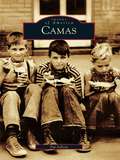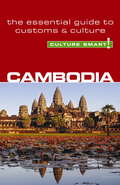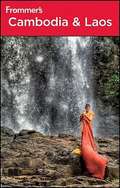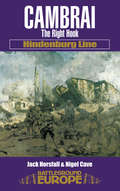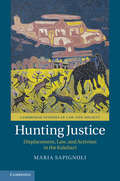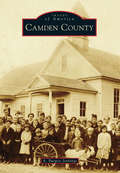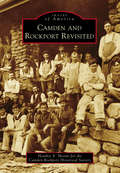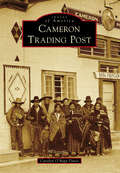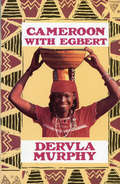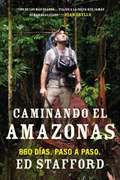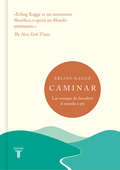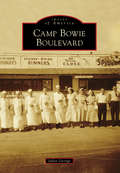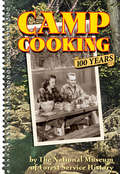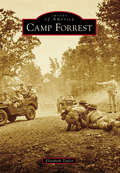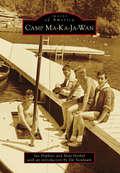- Table View
- List View
Camas
by Pat JollotaWhen Henry Pittock, the owner of the Oregonian, wanted a new paper mill to supply his newspaper, he chose a site 16 miles upriver from Vancouver. There he founded the LaCamas Colony in 1883, named after the Camas lily, a basic foodstuff of the Chinook tribes that inhabited the river. Agriculture was also a vibrant part of Camas, and today Prune Hill is a desirable part of town. Incorporated in 1906 as one means of controlling the sale of alcohol, Camas was the most active town in Prohibition in Clark County. During the middle of the last century, the flavor of the town began to change, as hightech companies of the "Silicon Forest" came to share the landscape with the paper mill and Douglas firs. Today's visitors stroll through charming cafes and antique shops at the Port of Camas, where a rough landing was once carved out of the thick forests above the Columbia River.
Cambodia - Culture Smart!: The Essential Guide to Customs & Culture
by Graham SaundersDon't pack anxiety in your suitcase! By reading Culture Smart! Cambodia before you go, will ease your travel, help you to make friends and avoid confusion. Culture Smart! Cambodia will help you to understand local manners, customs and laws. Culture Smart! Cambodia goes the extra mile to help you brush up on your cultural small talk and will make you confident in leaving your comfort zone far behind. Walk hand in hand with a Culture Smart! guide and avoid misunderstandings that could cost you valuable time, money and enjoyment. . . With Culture Smart! Cambodia you will learn about daily living, historical perspectives, taboos, business etiquette, eating and drinking and much more, allowing you to experience the country like a native. Be responsible, be Culture Smart!
Cambodia and Laos
by Daniel WhiteThis new first edition guide introduces two exotic destinations fast becoming required stops for globetrotting tourists. Through our expert author, readers are exposed to the rich culture and poignant history in Cambodia and Laos. Discover the region's food and gift markets, lovely beaches and islands, colorful temples, and charming villages. This title covers highlights of both countries, including Cambodia's tourist Mecca and spiritual center Angkor Wat, capital Phnom Penh, and beach resort Sihanoukville. Laos covers the relaxed city Vientiane, Luang Prabang (a UNESCO World Heritage city for its blend of Laotian and European architecture), and top spots for ecotourism. The planning chapter includes extensive information on sustainable development and volunteer vacations. Special features include a Khmer and Laotian language primer and separate history and culture chapters for both nations.
Cambrai: The Right Hook (Battleground Europe)
by Nigel CaveThis fully illustrated WWI battlefield guide provides essential historical context and visitor information for exploring this site on the Western Front. Located near the Belgian border, the French town of Cambrai was a vital supply point for the German forces along the Hindenburg Line. It is best known for the First Battle of Cambria, an epic tank battle which took place there in 1917. Although the British Expeditionary Force were successful in the first day of combat, the tables soon turned. As on other occasions throughout the War, the area changed hands many times. Illustrated with then and now pictures, this book presents a detailed overview of the battle from multiple perspectives. It then provides five walking tour itineraries taking readers through the La Vacquerie Battlefield, Bonavis Farm, Les Rues Vertes, Bapaume, and more.
Cambria
by Wayne AttoeLocated on the Pacific coast between San Francisco and Los Angeles, Cambria developed as a hub for lumbering, mining, whaling, and dairying in the 19th century. Situated in a pine forest and populated by immigrants from the eastern United States and numerous Swiss-Italians, it became the second largest town in San Luis Obispo County. When the railroad bypassed Cambria, the pace of life quieted for a time, and ranchers raised cattle for beef. But affordable automobiles and the construction of roads to the north and east turned the locale into a vacation destination. The cool climate, rugged cliffs, beaches, and signature Monterey pine forest brought a sizable new development called Cambria Pines. The opening of Hearst Castle as a state park assured Cambria's future as a tourist destination. The ways in which people have engaged with the local forest is a leitmotif in the account of these developments.
Cambridge (Images of America)
by Anthony Mitchell SammarcoSettled as New Towne in 1631, Cambridge was referred to by Wood, a seventeenth-century chronicler, as "one of the neatest and best compacted towns in New England." The founding of Harvard College in 1636 was to ensure the town's notoriety, as it was the first college in the New World. Harvard gaveCambridge a cosmopolitan flavor, but the town retained its open farmland and its well-known fisheries along the Charles and Alewife Rivers for nearly two centuries. By the early nineteenth century Cambridge saw tremendous development, with industrial concerns in Cambridgeport. New residents swelled Cambridge's population so much that it became a city in 1846. These changes, which included horse-drawn streetcars and, later, the Elevated Railway that is today known as the Red Line, made Cambridge a place of convenient residence. With the large-scale development in the late nineteenth century, Cambridge became a thriving nexus of cultural diversity.
Cambridge Springs and Edinboro (Postcard History)
by Terry Perich Kathleen PerichThe penny postcard became popular during the years that mineral water therapy changed the quiet, rural town of Cambridge Springs into a popular resort town. Hotels and spas fi lled the area, and several daily trains brought guests to this world-class resort town. Hotels such as the Riverside, Rider, and Bartlett brought wonder and hope to people seeking cures for illnesses. Edinboro, known for its university and lake, has been another popular vacation spot for more than 200 years. The town developed an academy that became a normal school, a college, and finally a university. Through historic postcards, Cambridge Springs and Edinboro invites readers to witness the past wonders of this beautiful area.
Cambridge Studies in Law and Society: Displacement, Law, and Activism in the Kalahari (Cambridge Studies in Law and Society)
by Maria SapignoliThis book presents a long-term study of the activist campaign that contested the Botswana government's much-publicized removal of the San and Bakgalagadi people from the Central Kalahari Game Reserve. Sapignoli's multiple points of observation and analysis range from rural Botswana to the nation's High Court, and a variety of United Nations agencies in their Headquarters, focusing on rights claimants and officials from NGOs, states and the United Nations as they acted on the grievances of those who had been displaced. In offering a comprehensive discussion of the San people and their claims-making through formal institutions, this book maintains a consistent focus on the increased recourse to law and the everyday experience of those who are asserting their rights in response to the encroachments of the state and the opportunities inherent in new indigenous advocacy networks.
Cambridge Studies in Nineteenth-Century Literature and Culture: Writing Arctic Disaster
by Adriana CraciunHow did the Victorian fixation on the disastrous John Franklin expedition transform our understanding of the Northwest Passage and the Arctic? Today we still tend to see the Arctic and the Northwest Passage through nineteenth-century perspectives, which focused on the discoveries of individual explorers, their illustrated books, visual culture, imperial ambitions, and high-profile disasters. However, the farther back one looks, the more striking the differences appear in how Arctic exploration was envisioned. Writing Arctic Disaster uncovers a wide range of exploration cultures: from the manuscripts of secretive corporations like the Hudson's Bay Company, to the nationalist Admiralty and its innovative illustrated books, to the searches for and exhibits of disaster relics in the Victorian era. This innovative study reveals the dangerous afterlife of this Victorian conflation of exploration and disaster, in the geopolitical significance accruing around the 2014 discovery of Franklin's ship Erebus in the Northwest Passage.
Camden County
by A. Burgess JenningsCamden County extends southward from the Virginia line as a peninsula between the North and Pasquotank Rivers into the Albemarle Sound. Named for Revolutionary sympathizer Sir Charles Pratt, the first Earl of Camden, the county was formed on May 9, 1777. Construction of the 22-mile Dismal Swamp Canal began in 1793. The Battle of South Mills was fought on April 19, 1862, in an unsuccessful attempt by the Union to destroy the lock at South Mills. Camden County has continued as a rural community with farming, fishing, and logging as its citizens' primary occupations. Over time, horses, mules, and oxen have been replaced with tractors and combines. The Great Dismal Swamp National Wildlife Refuge was created in 1973, and the Dismal Swamp Canal, which has survived as the oldest artificial waterway in the United States, continues to serve boaters on the Intracoastal Waterway today. Camden County showcases the rich agricultural heritage of this North Carolina coastal county.
Camden and Rockport Revisited
by Heather E. Moran Camden-Rockport Historical SocietyThe towns of Camden and Rockport have had a rich, intertwined history since the first settlements in the mid-1700s. Until 1891, they were one town, built on the abundant natural resources of coastal Maine. Many residents in the early 19th century were farmers that carved out a living from the soil, or fishermen that harvested the teeming waters of Penobscot Bay. As the towns grew, successful industries were established that sustained the communities through the mid-20th century. These included fishing, textile mills, lime manufacturing, an anchor factory, and shipbuilding. Majestic schooners were built in the shipyards, and businesses such as the Bay View House hotel, S.B. Haskell's clothing store, numerous livery stables and harness shops, Joseph Brewster's Shirt Manufactory, and Knowlton Brothers Foundry lined the main thoroughfares. In Rockport, the Shepherd Company supplied lime, and the Rockport Ice Company cut ice on Lily Pond to be shipped as far as the Caribbean. These tight-knit villages, nestled "where the mountains meet the sea," weathered fires and wars, celebrated the launches of massive sailing vessels, and welcomed summer "rusticators" who helped form a lasting legacy of arts, culture, and learning that continues to draw visitors today.
Cameron Trading Post (Images of America)
by Carolyn O'Bagy DavisIn 1911, a one-track suspension bridge was constructed over the gorge of the Little Colorado River, bypassing a treacherous river crossing and opening travel to northern Arizona. Five years later, Hubert Richardson built a tin-roofed shack on the river's rim and opened his trading post for business. In the first years, almost all of his customers were Navajo, but with the new bridge travelers soon found the area, and it became the access point for the Grand Canyon, Glen Canyon, and the Four Corners area. A century later, Cameron Trading Post is a thriving epicenter still serving Navajo people, tourists, and an impressive list of the famous and fascinating, including authors, scientists, and movie stars. Boasting a curio store, gas station, motel, RV park, grocery store, and art gallery, Cameron is visited by guests from all over the world. It is a crossroads and a destination for visitors to this historic trading post.
Cameroon with Egbert
by Dervla MurphyThe author recounts her adventures in Cameroon. Travelling with her daughter and accompanied by a Cameroonian horse they overcome floods, malaria, marriage proposals from tribal chiefs, and stray into a restricted zone around Lake Nyos, where a cloud of volcanic gas had recently killed over 2,000 villagers. The author also wrote Muddling Through in Madagascar, On a Shoestring to Coorg and The Waiting Land.
Cameroon with Egbert
by Dervla MurphyThe author recounts her adventures in Cameroon. Travelling with her daughter and accompanied by a Cameroonian horse they overcome floods, malaria, marriage proposals from tribal chiefs, and stray into a restricted zone around Lake Nyos, where a cloud of volcanic gas had recently killed over 2,000 villagers. The author also wrote Muddling Through in Madagascar, On a Shoestring to Coorg and The Waiting Land.
Cameroon with Egbert
by Dervla MurphyCameroon with Egbert tells the story of a journey through the remote areas of Cameroon undertaken by indomitable author Dervla Murphy and her daughter Rachel, accompanied by an endearing horse named Egbert. During the course of their wanderings they are frequently mistaken for husband and wife, forcing Dervla to bare her chest to prove her femininity; they continually get lost, are obliged to eat repulsive local delicacies; are arrested, fall ill, are baked by the sun and soaked by tropical storms and, disastrously, lose Egbert. The two women's charm, wit and sense of adventure shine through all these setbacks, which would have daunted lesser travellers. They eventually leave this laid-back, peaceful country with great reluctance, having been 'enspelled' by its beauty and the friendliness of the Cameroonians.
Camille: The Final Paris Crime Files Thriller
by Pierre LemaitreMEET COMMANDANT CAMILLE VERHOEVEN OF THE PARIS POLICE WITH NOTHING ELSE TO LOSEAnne Forestier finds herself in the wrong place at the wrong time when she blunders into a raid on a jeweller's on the Champs-Élysées. Bludgeoned beyond recognition, she is lucky to survive. But her ordeal has only just begun.HE CAN BREAK ALL THE RULESLying helpless in her hospital bed, with her assailant still at large, Anne is in mortal danger. Only one thing gives her hope: Commandant Camille Verhœven.TO PROTECT THE WOMAN HE LOVES For Verhœven it's a case of history repeating itself. He cannot lose Anne as he lost his wife. This time he faces an adversary whose greatest strength appears to be Verhœven's matchless powers of intuition.Winner of the 2015 C.W.A. International Dagger
Camille: The Final Paris Crime Files Thriller (The Paris Crime Files #3)
by Pierre LemaitreMEET COMMANDANT CAMILLE VERHOEVEN OF THE PARIS POLICE WITH NOTHING ELSE TO LOSEAnne Forestier finds herself in the wrong place at the wrong time when she blunders into a raid on a jeweller's on the Champs-Élysées. Bludgeoned beyond recognition, she is lucky to survive. But her ordeal has only just begun.HE CAN BREAK ALL THE RULESLying helpless in her hospital bed, with her assailant still at large, Anne is in mortal danger. Only one thing gives her hope: Commandant Camille Verhœven.TO PROTECT THE WOMAN HE LOVES For Verhœven it's a case of history repeating itself. He cannot lose Anne as he lost his wife. This time he faces an adversary whose greatest strength appears to be Verhœven's matchless powers of intuition.Winner of the 2015 C.W.A. International Dagger
Camille: The Final Paris Crime Files Thriller (The Paris Crime Files #3)
by Pierre LemaitreWinner of the 2015 C.W.A. International Dagger. Anne Forestier finds herself in the wrong place at the wrong time when she blunders into a raid on a jewellers on the Champs-Élysées. Shot three times, beaten almost beyond recognition, she is lucky to survive, but her ordeal has only just begun. Lying helpless in her hospital bed, with her assailant still at large, Anne is in grave danger. Just one thing stands in her favour - a partner who will break all the rules to protect the woman he loves: Commandant Camille Verhœven. For Verhœven it's a case of history repeating. He cannot lose Anne as he lost his wife Irène. But his serious breach of protocol - leading a case in which he is intimately involved - leaves him out on a limb, unable to confide in even his most trusted lieutenants. And this time he is facing an adversary whose greatest strength appears to be Verhœven's own matchless powers of intuition.(P)2015 WF Howes Ltd
Caminando el Amazonas
by Ed StaffordLa apasionante narración del histórico recorrido de un hombre a lo largo de todo el Amazonas--y a través del medio ambiente de mayor diversidad biológica del planeta. En abril del 2008, Ed Stafford inició su trayecto para convertirse en el primer hombre en caminar por todo lo largo del Amazonas. Comenzó en la costa pacífica del Perú, y cruzó la cordillera de los Andes para encontrar la fuente oficial del río. Su viaje lo condujo a través de partes de Colombia y por medio del Brasil, mientras burlaba animales peligrosos e indígenas de machete en ristre, al tiempo que sufría lesiones, se enfrentaba al clima y confrontaba sus propios temores y dudas. Pero Stafford no se dio por vencido. En su agotador viaje de 860 días y más de 4,000 millas, Stafford fue testigo directo de la devastación de la deforestación selvática, de la presión con que viven las tribus a causa de la pérdida de su medio ambiente natural, así como de la naturaleza en su manifestación más genuina y cruda. Caminando el Amazonas, asombroso de principio a fin, es tan apasionante como los libros de Bill Bryson, Jon Krakauer y David Grann Caminando el Amazonas es la historia inolvidable de una aventura sin precedente.
Caminando el Amazonas
by Ed StaffordLa apasionante narración del histórico recorrido de un hombre a lo largo de todo el Amazonas--y a través del medio ambiente de mayor diversidad biológica del planeta.En abril del 2008, Ed Stafford inició su trayecto para convertirse en el primer hombre en caminar por todo lo largo del Amazonas. Comenzó en la costa pacífica del Perú, y cruzó la cordillera de los Andes para encontrar la fuente oficial del río. Su viaje lo condujo a través de partes de Colombia y por medio del Brasil, mientras burlaba animales peligrosos e indígenas de machete en ristre, al tiempo que sufría lesiones, se enfrentaba al clima y confrontaba sus propios temores y dudas.Pero Stafford no se dio por vencido. En su agotador viaje de 860 días y más de 4,000 millas, Stafford fue testigo directo de la devastación de la deforestación selvática, de la presión con que viven las tribus a causa de la pérdida de su medio ambiente natural, así como de la naturaleza en su manifestación más genuina y cruda. Caminando el Amazonas, asombroso de principio a fin, es tan apasionante como los libros de Bill Bryson, Jon Krakauer y David Grann. Caminando el Amazonas es la historia inolvidable de una aventura sin precedente.
Caminar: Las ventajas de descubrir el mundo a pie
by Erling KaggeTras el éxito internacional El silencio en la era del ruido, Erling Kagge nos deleita con un libro sobre el placer de caminar. Libros que respiran y te hacen respirar. «Casi todos los problemas parecen distintos después de un paseo.» Al caminar, con o sin rumbo, nuestro cuerpo viaja a la velocidad de nuestra mente. Solo cuando damos un paso tras otro podemos descubrir la tierra que pisamos, y a nosotros mismos. La capacidad de andar erguidos nos convirtió en lo que somos, y al dejar de caminar abandonamos también nuestra esencia, nos convertimos en otra cosa. Este libro, una agradable caminata en excelente compañía, nos recuerda la alegría de las caminatas, breves o largas, y nos convence de que quien va a pie llega más lejos y vive mejor. En el camino, nuestros pasos se cruzan con figuras como Machado, Heidegger, Thoreau, Neruda o Steve Jobs. Erling Kagge, el autor que nos enseñó a encontrar el silencio en este estruendoso mundo, vuelve con un evocador libro sobre el placer y el equilibrio que se pueden encontrar en tan simple actividad. La crítica ha dicho...«Erling Kagge es un aventurero filosófico, o quizás un filósofo aventurero.»The New York Times «¿Quién mejor que un avezado explorador para hablarnos del silencio? El silencio está en todos lados. Basta con reconocerlo y saborearlo. Toda una filosofía de vida. Y también una nueva forma de lujo que ya tiene numerosos adeptos.»Le Figaro Magazine (sobre El silencio) «Una valiosa guía en la que Kagge da cuenta de los inestimables beneficios de encontrar la quietud. Para él, desconectar no significa alejarse del mundo. Al contrario: se trata de disfrutar más intensamente de la vida y de la compañía.»L'Express (sobre El silencio)
Camp Bowie Boulevard
by Juliet GeorgeIn the early 1890s, Humphrey Barker Chamberlin installed a lifeline to his namesake suburb west of the city. A trolley connected to Arlington Heights Boulevard at the Trinity River's Clear Fork and chugged across prairie land to reach Chamberlin Arlington Heights. Camp Bowie, a soldiers' city, sprawled over both sides of the road from 1917 until 1919. At the Great War's end, the stretch west of present-day University Drive became the commemorative Camp Bowie Boulevard. The 1920s brought twin ribbons of cordovan-colored brick pavement, the prestige of inclusion in the Bankhead Highway network, and westering developers of another elite village: Ridglea. Midway through the Great Depression, the Will Rogers complex arose on a farm tract, visible from the thoroughfare, to host Texas Centennial celebrations and a special livestock exposition. Museums began claiming adjacent space in the 1950s. By the second decade of the 21st century, Camp Bowie Boulevard bisected a built environment both modern and historic.
Camp Cooking: 100 Years
by The National Museum of Forest Service HistoryPhotos, anecdotes, and outdoor-cooking recipes celebrating the history of the U.S. Forest Service. Dedicated protectors of our national forests and grasslands, Forest Service agents live much of their lives outdoors, and that includes mealtimes. In decades past, rangers&’ wives prepared meals with limited resources as they accompanied their husbands in the field, often supplementing cooking with k-rations cooked over an open fire. In rustic and remote locations, delicious, time-tested creations were prepared and served, including Dutch Oven Beer Bread, Parmesan Mashed Potatoes, Pioneer Night Stew, and Creamy Pumpkin Pie. Here, the National Museum of Forest Service History presents a unique cookbook that celebrates decades of camp cooking by countless Forest Service agents in the field. Featuring legendary recipes for Dutch oven meals, open-fire dishes, and other tasty outdoor specialties used daily in the early days of the Forest Service, Camp Cooking also includes photos and anecdotes that tell the whole history of these brave and hardy individuals.
Camp Forrest (Images of America)
by Elizabeth TaylorCamp Forrest was a training, induction, and combatant prisoner-of-war (POW) facility located on the outskirts of Tullahoma, Tennessee. It was a self-sustaining city where over 70,000 soldiers were stationed and approximately 12,000 civilians were employed throughout World War II. In 1942, the camp transitioned to an enemy alien internment camp and was one of the first civilian internment camps in the United States. By the middle of 1943, it had transitioned into a POW camp and housed primarily German and Italian prisoners. After the war ended, the base was decommissioned and dismantled in 1946. In 1951, the area was recommissioned and expanded into the US Air Force's Arnold Engineering Development Complex. Few remains of this important World War II facility exist today; however, the images within provide a glimpse into the effects and realities of a global war on American soil.
Camp Ma-Ka-Ja-Wan (Images of America)
by Matt Horbal Jim Neubaum Ian HopkinsCamp Ma-Ka-Ja-Wan opened in the summer of 1929 with a vision of providing an outdoor experience for young people. It is owned and operated by the Northeast Illinois Council, Boy Scouts of America (BSA), in Highland Park, Illinois, and located in Pearson, Wisconsin. The camp's name comes from the Native American phrase meaning "spring fed lake" and originated in a contest won by a Scout from the North Shore Area Council, BSA. Thousands of young people and adults have hiked the trails, boated on the lakes, developed their scouting skills, and had countless adventures at the camp. The stories of how the camp was developed, built, and maintained by the North Shore Area Council, BSA, during difficult times, including war and the Great Depression, are shared within. Camp Ma-Ka-Ja-Wan still serves young people, adults, and families from more than 40 communities.
